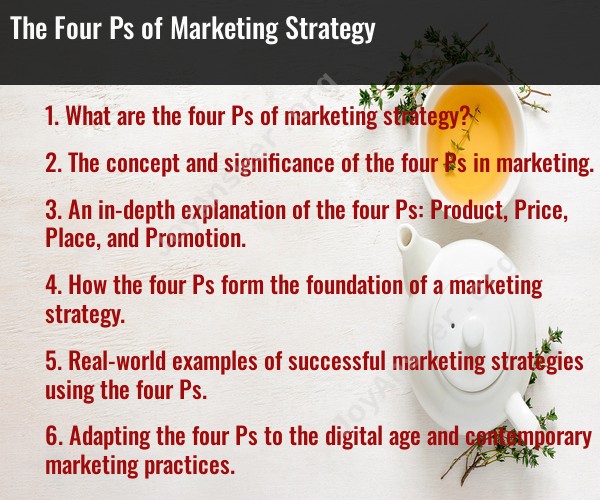What are the four Ps of marketing strategy?
The Four Ps of marketing, also known as the marketing mix, are a fundamental framework that businesses use to develop and implement their marketing strategies. These elements help in shaping a marketing plan to meet the needs and wants of the target market. The Four Ps are:
Product: This refers to the actual goods or services that a company offers to its customers. It involves decisions about product design, features, quality, branding, packaging, and more. Companies need to ensure that their products or services align with the needs and desires of their target market.
Price: Pricing is a crucial aspect of marketing strategy. It involves setting the right price for your product or service to maximize profits while remaining competitive. Pricing strategies can include setting premium prices, discount pricing, value-based pricing, and more.
Place (Distribution): This involves decisions about how and where customers will access the product or service. Distribution channels, retail locations, online presence, and logistics all fall under this category. The goal is to make the product readily available to the target market.
Promotion: Promotion encompasses all the activities that a company engages in to communicate the value of its product or service to the target market. This includes advertising, public relations, sales promotions, social media marketing, and other promotional tactics.
These Four Ps should be analyzed and adjusted in accordance with the specific needs and preferences of the target market. Additionally, in more modern marketing discussions, three additional Ps are sometimes added to the mix:
People: This relates to the people within the organization and their role in delivering the product or service. Employee training, customer service, and the overall customer experience are critical aspects.
Process: This includes the procedures and systems used to deliver the product or service. An efficient and effective process can improve customer satisfaction and reduce costs.
Physical Evidence: In the case of service businesses, this refers to the physical or tangible cues that help customers evaluate the service. It might include the physical environment, equipment, or other tangible aspects that influence the service experience.
These additional Ps expand the traditional marketing mix to better suit the service and experience-oriented nature of many businesses today. Together, these elements help companies create a comprehensive marketing strategy that aligns with customer needs and market dynamics.
The concept and significance of the four Ps in marketing
The four Ps of marketing, also known as the marketing mix, are a framework for understanding and implementing marketing strategies. The four Ps are:
- Product: The good or service that a company offers to its customers.
- Price: The amount of money that customers pay for the product.
- Place: Where and how the product is made available to customers.
- Promotion: The activities that a company undertakes to communicate with and persuade customers to buy its product.
The four Ps are significant because they provide a holistic approach to marketing. By considering all four Ps, marketers can develop strategies that are more likely to be successful in meeting their marketing goals.
An in-depth explanation of the four Ps: Product, Price, Place, and Promotion
Product
The product is the core of any marketing strategy. It is what customers are buying and what meets their needs or desires. Marketers must carefully consider the following factors when developing their product strategy:
- Features and benefits: What are the key features and benefits of the product? How does it meet the needs of the target market?
- Branding: What is the product's brand identity? How will it be differentiated from the competition?
- Packaging: How will the product be packaged? The packaging should be attractive and informative, and it should protect the product during shipping and handling.
Price
The price of a product is an important factor that influences customer purchase decisions. Marketers must set a price that is competitive and profitable, while also being perceived as fair by customers. The following factors should be considered when setting the price of a product:
- Production costs: How much does it cost to produce the product?
- Competitors' prices: How are competitors pricing similar products?
- Target market: What is the target market's willingness to pay for the product?
- Marketing goals: Is the goal to maximize profits or market share?
Place
The place refers to where and how the product is made available to customers. Marketers must decide which distribution channels to use, such as retail stores, online marketplaces, or direct sales. The following factors should be considered when developing a place strategy:
- Target market: Where does the target market shop?
- Competitors: Where are competitors selling their products?
- Product type: Is the product best suited for sale in physical stores or online?
- Cost: What are the costs associated with different distribution channels?
Promotion
The promotion mix refers to the activities that a company undertakes to communicate with and persuade customers to buy its product. Common promotional activities include advertising, public relations, sales promotions, and direct marketing. The following factors should be considered when developing a promotional strategy:
- Target market: What are the target market's media consumption habits?
- Budget: How much money is available for promotion?
- Marketing goals: What are the specific goals of the promotional campaign?
How the four Ps form the foundation of a marketing strategy
The four Ps of marketing form the foundation of a marketing strategy by providing a framework for marketers to develop and implement strategies that are more likely to be successful in meeting their marketing goals.
For example, a company that is launching a new product must consider all four Ps when developing its marketing strategy. The company must carefully define the product's features and benefits, set a competitive price, choose the appropriate distribution channels, and develop a promotional campaign that will reach the target market and persuade them to buy the product.
Real-world examples of successful marketing strategies using the four Ps
Here are a few real-world examples of successful marketing strategies that have used the four Ps to achieve their goals:
- Apple: Apple is known for its innovative products, sleek design, and premium pricing. The company also has a strong brand identity and a loyal customer base. Apple's marketing strategy is focused on promoting the unique features and benefits of its products, while also creating a sense of exclusivity and desirability.
- Coca-Cola: Coca-Cola is one of the most recognizable brands in the world. The company has a global distribution network and invests heavily in advertising and promotions. Coca-Cola's marketing strategy is focused on creating a positive brand image and promoting its products as a symbol of happiness and togetherness.
- Amazon: Amazon is a leading online retailer that offers a wide range of products at competitive prices. The company also offers convenient delivery options and a user-friendly shopping experience. Amazon's marketing strategy is focused on providing customers with a convenient and affordable shopping experience, while also promoting its unique features and benefits, such as Amazon Prime.
Adapting the four Ps to the digital age and contemporary marketing practices
The four Ps of marketing are still a valuable framework for developing













